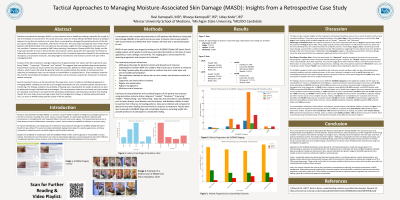Case Series/Study
(CS-070) Tactical Approaches to Managing Moisture-associated Skin Damage (MASD): Insights from a Retrospective Case Study
Friday, May 2, 2025
7:45 PM - 8:45 PM East Coast USA Time

Bhavya Kamepalli, BS Neuroscience; Uday Kode, BS Biology
Introduction: Moisture-associated skin damage, MASD, is a very common issue in healthcare settings, especially for people at risk of immobility or incontinence. The sacral and coccyx areas are mostly affected by MASD because prolonged exposure to any form of moisture, be it urine, feces, or perspiration, damages the protective barrier of the skin and causes inflammation, maceration, and erosion of the skin. This case-study retrospective chart review of 185 patients with MASD located in the sacral/coccyx area provides insight into the management and outcomes of this condition.
Methods: Treatment consisted of AMD Gauze dressing, Calmoseptine Ointment (60% Zinc Oxide), and No Sting Cyanoacrylate to assist in skin protection and moisture control, along with skin separation techniques to reduce the accumulation of moisture under the folds of skin. Consistent supervision allowed for the monitoring of progress, and proactive measures, including hygiene maintenance and moisture control, were part of the management plan.
Results: Analysis of the data revealed an average healing time of approximately 4.51 weeks, with the majority of cases being "Stable," "Improving," “Resolved,” and “Healed.” This suggests that most patients experienced positive improvement; however, 8 cases had less than favorable outcomes, defined as "Deteriorating" or "Worsening" statuses, which means that while the general trends are usually positive, the speeds of improvement and responses to therapeutic input can vary based on comorbidities or outlying factors. These variations underline the need for personalized and adaptive treatment plans and a continuous assessment mechanism to improve patient outcomes.
Discussion: Several important lessons can be learned from this experience. First, it enables a multifaceted approach to managing MASD, including not only the use of targeted treatments but also consistent patient education and monitoring. The findings underline the variability of healing rates, meaning that the needs of patients can best be addressed through individualized care strategies. This retrospective review has also found early intervention and repeated assessment to be important for preventing complications and improving outcomes from healing. Overall, this case study shows the huge impact that this management strategy, combined with personalized care, can have on MASD healing and the quality of life for patients.
Methods: Treatment consisted of AMD Gauze dressing, Calmoseptine Ointment (60% Zinc Oxide), and No Sting Cyanoacrylate to assist in skin protection and moisture control, along with skin separation techniques to reduce the accumulation of moisture under the folds of skin. Consistent supervision allowed for the monitoring of progress, and proactive measures, including hygiene maintenance and moisture control, were part of the management plan.
Results: Analysis of the data revealed an average healing time of approximately 4.51 weeks, with the majority of cases being "Stable," "Improving," “Resolved,” and “Healed.” This suggests that most patients experienced positive improvement; however, 8 cases had less than favorable outcomes, defined as "Deteriorating" or "Worsening" statuses, which means that while the general trends are usually positive, the speeds of improvement and responses to therapeutic input can vary based on comorbidities or outlying factors. These variations underline the need for personalized and adaptive treatment plans and a continuous assessment mechanism to improve patient outcomes.
Discussion: Several important lessons can be learned from this experience. First, it enables a multifaceted approach to managing MASD, including not only the use of targeted treatments but also consistent patient education and monitoring. The findings underline the variability of healing rates, meaning that the needs of patients can best be addressed through individualized care strategies. This retrospective review has also found early intervention and repeated assessment to be important for preventing complications and improving outcomes from healing. Overall, this case study shows the huge impact that this management strategy, combined with personalized care, can have on MASD healing and the quality of life for patients.

.jpg)